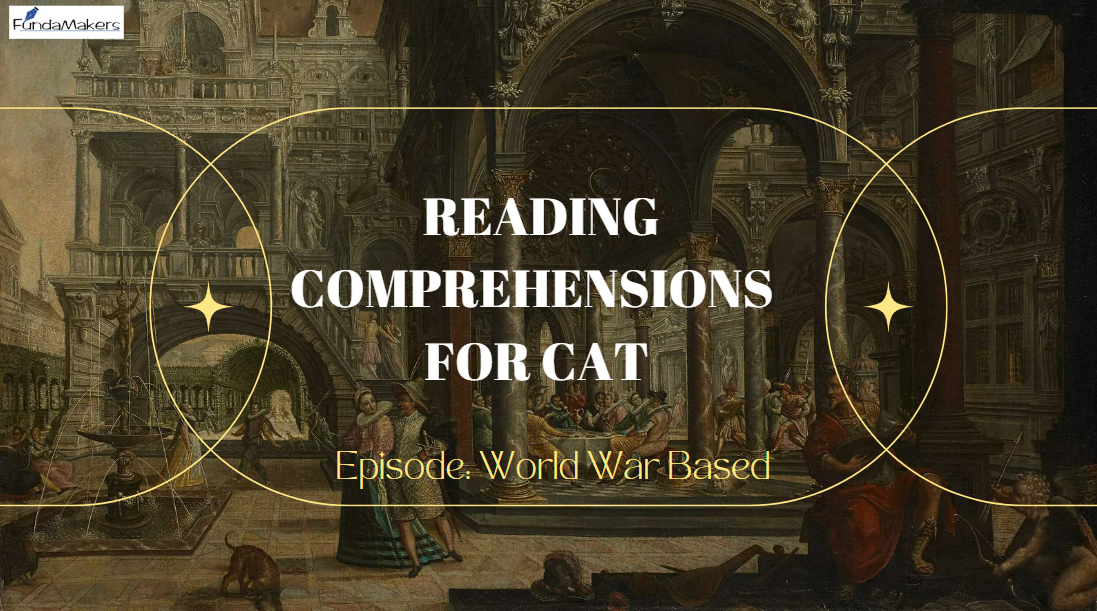In the competitive realm of the Common Admission Test (CAT), mastering reading comprehension is crucial for success, and war-based passages play a pivotal role in this preparation. These passages, often dense with historical context and complex themes, challenge candidates to hone their analytical skills, enhance their critical thinking, and develop a nuanced understanding of intricate narratives. By engaging with war-based reading comprehensions, CAT aspirants not only broaden their knowledge but also sharpen their ability to dissect and interpret sophisticated texts—a skill set indispensable for achieving high scores and excelling in subsequent management studies.
Let’s have a look at few passages given below:
Passage 1.
India’s contributions to the war, both material and financial, were highly significant. The country became a crucial military-industrial and logistical hub for Allied operations in Southeast Asia and the Middle East. This strategic importance drew considerable attention from the United States, ensuring that India’s future was no longer solely under British control. Several wartime developments hinted towards India’s impending independence. Notably, India ended the war as one of Britain’s largest creditors, marking a remarkable turnaround in their financial relationship.
However, this extraordinary wartime effort came at a tremendous human cost, with the Bengal famine being the most severe example of the widespread deprivation experienced during the war. The toll on India’s civilian population was immense, costing millions of lives.
Many Indians volunteered for service both at home and abroad for various reasons, with the belief that their efforts might lead to India’s freedom. The war-induced political and social upheaval led to widespread protests and unrest across rural and urban India after the conflict, which played a key role in convincing the Attlee government to end British rule over India. Seventy years later, it is imperative for India to reflect on the complex legacies of the Second World War. Incorporating the war into the new national memorial would be an appropriate and overdue acknowledgment that it was indeed India’s war.
Questions
- What was one of the major impacts of India’s involvement in the war on its relationship with Britain?
- A) India became more dependent on British financial aid.
- B) India became one of the largest creditors to Britain.
- C) Britain took complete control of India’s resources.
- D) India lost significant territories to Britain.
- Correct Option: B
- Which event is highlighted as the most extreme example of wartime deprivation in India?
- A) The partition of India.
- B) The Quit India Movement.
- C) The Bengal famine.
- D) The Salt March.
- Correct Option: C
- What motivated many Indians to volunteer for war service?
- A) The promise of financial rewards.
- B) The chance to travel abroad.
- C) The belief that it would lead to India’s independence.
- D) The influence of British propaganda.
- Correct Option: C
- What was a significant outcome of the post-war political and social unrest in India?
- A) Increased British military presence.
- B) The initiation of World War III.
- C) The Attlee government’s decision to end British rule in India.
- D) India’s financial collapse.
- Correct Option: C
Passage 2
In the late 1930s, global financial hardships led many people to seek leaders who could improve their lives. Unfortunately, in Germany, Italy, and Japan, dictators rose to power—leaders who seize control by force. Germany was led by Adolf Hitler, Italy by Benito Mussolini, and Japan by Emperor Hirohito. They established totalitarian regimes, single-party governments that suppress opposition and control citizens’ lives. These dictators aimed to expand their territories, but initially, the world did little to intervene. Hitler’s Germany invaded countries such as Poland, Austria, Czechoslovakia, and Russia, and targeted Jews and other minorities in a campaign of terror, resulting in over six million Jewish deaths during the Holocaust. Hitler aspired to conquer Europe and beyond.
Mussolini’s Italy invaded Ethiopia and other African countries, while Japan’s military attacked China and Pacific islands. The Japanese attack on Pearl Harbor on December 7, 1941, which killed over 2,400 people and wounded another 1,700, propelled the United States into World War II. President Franklin D. Roosevelt, with British Prime Minister Winston Churchill, declared war on Japan. Subsequently, Germany declared war on the U.S. The United States led the Allied Powers, which included Great Britain, the Soviet Union, China, and France, against the Axis Powers of Germany, Japan, and Italy. The conflict spanned many battles across Europe, Northern Africa, and the Pacific.
The European war ended on June 6, 1944, with the Allied invasion of Normandy, known as D-Day. Although Germany was initially pushed out of France, it made a final counterattack during the Battle of the Bulge. Eventually, Germany was defeated and surrendered on May 7, 1945. Despite the end of the European war, Japan continued fighting in the Pacific until the United States dropped atomic bombs on Hiroshima on August 6, 1945, and Nagasaki on August 9, 1945, killing at least 120,000 people. Japan surrendered on August 14, 1945, marking the end of World War II—the only instance where nuclear weapons were used in war.
Questions
- Which countries were led by dictators in the late 1930s?
- A) Germany, Italy, and Japan
- B) Germany, France, and Italy
- C) Japan, Russia, and Germany
- D) Italy, China, and Germany
- Correct option: A)
- What event caused the United States to enter World War II?
- A) The invasion of Normandy
- B) The attack on Pearl Harbor
- C) The Battle of the Bulge
- D) The fall of France
- Correct option: B)
- What was the Holocaust?
- A) The invasion of Ethiopia by Italy
- B) The Japanese attack on China
- C) The systematic extermination of Jews and other minorities by Nazi Germany
- D) The dropping of atomic bombs on Japan
- Correct option: C)
- When did Germany surrender in World War II?
- A) August 14, 1945
- B) June 6, 1944
- C) December 7, 1941
- D) May 7, 1945
- Correct option: D)
Passage 3
The Cold War, which lasted from about 1945 to 1990, was a prolonged period of tension between the Soviet Union (now Russia) and the United States, without direct military conflict. Following the end of World War II in 1945, when Germany surrendered to the Allies, including the U.S., Britain, France, and the Soviet Union, the cooperation between the Soviet Union and the U.S. against Nazi Germany gave way to rivalry. This shift began with the division of Germany among the Allies, where the Soviet-controlled portion became a communist state mirroring the Soviet Union, characterized by elections, restricted freedoms, a weak economy, dictatorship, media censorship, and a pervasive secret police. In 1961, the Berlin Wall was erected to separate the communist-controlled East Berlin from West Berlin.
The United States and its allies disapproved of these changes, and East Germans found themselves trapped, unable to leave, under strict Soviet control. The global community watched the escalating tensions between the two superpowers. Both nations sought to expand their influence worldwide and engaged in a race to develop weapons of mass destruction, including nuclear arms. The relationship between the Soviet leader, Joseph Stalin, and U.S. President Harry Truman soured when Truman did not inform Stalin about the use of the atomic bomb on Japan, causing Stalin to fear that the U.S. might one day use such a weapon against the Soviet Union.
Numerous incidents during the Cold War heightened the friction between the two countries. In the United States, many celebrities were baselessly accused of being communists. The Soviets successfully tested their own nuclear weapons in 1949, and from 1950 to 1953, the Korean War saw North Korea’s attempt to spread communism to the South.
Questions
- When did the Cold War take place?
- a) 1939-1945
- b) 1945-1990
- c) 1950-2000
- d) 1960-1985
- Correct option: b) 1945-1990
- What was the significant feature of East Germany under Soviet control?
- a) A strong economy
- b) Democracy and free elections
- c) Media censorship and a secret police society
- d) Open borders with the West
- Correct option: c) Media censorship and a secret police society
- What event led to Joseph Stalin’s distrust of Harry Truman?
- a) The Berlin Wall construction
- b) The Korean War
- c) Truman not informing Stalin about the atomic bomb used in Japan
- d) The Soviet’s first successful nuclear test
- Correct option: c) Truman not informing Stalin about the atomic bomb used in Japan
- Which conflict occurred between 1950 and 1953, intensifying Cold War tensions?
- a) World War II
- b) The Vietnam War
- c) The Korean War
- d) The Cuban Missile Crisis
- Correct option: c) The Korean War
Test your Caliber with us!
FundaMakers provide a series of RCs, and previous year questions based on RCs on our site. Tap on ” CAT Question Bank” and visit our Question bank section perfectly tailored for CAT aspirants.
Visit the link below to read passages based on Psychology for VARC Preparation in CAT:



